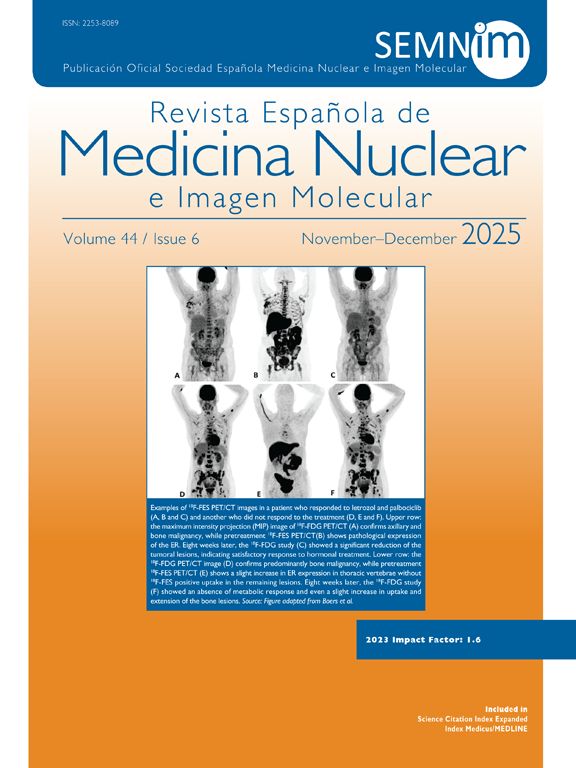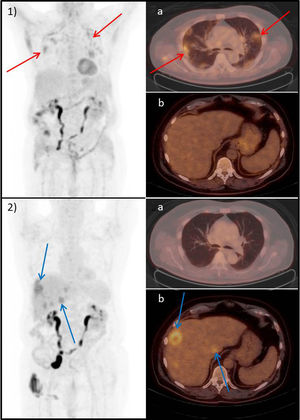68-year-old man presenting with urothelial carcinoma in complete response after cystoprostatectomy and chemotherapy. An abdomine-pelvic CT scan performed in an external center showed retroperitoneal adenopathies suspicious of tumor recurrence. These finding led to a baseline 18F-FDG PET/CT. The baseline 18F-FDG PET/CT performed did not show hypermetabolic lesions suspicious of local recurrence nor lymph nodes (including retroperitoneal territories) nor metastases. However, the study showed peripheral bilateral pulmonary hipermetabolic ground-glass opacities1 predominantly in the superior lobes, suggestive of active pulmonary infectious disease (probably COVID-19 in the current pandemic context). When the baseline 18F-FDG PET/CT was performed the patient was asymptomatic and we suggested him to undergo reverse transcription–polymerase chain reaction (RT-PCR) of the nasopharyngeal exudate, but the patient did not consult. After 5 days in quarantine, the patient re-consulted due to symptoms compatible with pneumonia, being diagnosed by RT-PCR of SARS-COV-2 (Severe Acute Respiratory Syndrome Coronavirus 2, for its acronym). The patient received incomplete treatment with hydroxychloroquine and oxygenotherapy due to voluntary abandonment. Three months later, while the patient was asymptomatic, a follow-up 18F-FDG PET/CT was performed, and showed multiple liver metastases (Fig. 1-1b, red arrows) and resolution of the bilateral hypermetabolic pulmonary opacities (Fig. 2a).
68-year-old man with urothelial carcinoma in complete response after cystoprostatectomy and chemotherapy. Baseline 18F-FDG PET/CT (image 1) showed multiple peripheral bilateral pulmonary hipermetabolic ground-glass opacities predominantly in superior lobes, suggestive of active pulmonary infectious disease (image 1a; red arrows), without other hypermetabolic lesions suggestive of malignancy (Image 1-1b). The follow-up 18F-FDG PET/CT (performed 3 months after baseline PET/CT; image 2) showed resolution of the bilateral pulmonary ground-glass opacities (image 2a) and multiple hypermetabolic liver lesions suggestive of liver metastases (segment I and segment VIII; image 2b; blue arrows).
This image highlights the usefulness of 18F-FDG PET/TC in the early detection of asymptomatic patients with COVID-191 and its potential utility in the follow-up of these group of patients. To the extent of our knowledge, no cases of follow-up 18FDG-PET/CT have been reported in oncological patients with COVID-19. This image also highlights the good sensitivity of 18F-FDG PET/CT to assess evolution and possible secuelae of SARS-COV-2.2 However, 18F-FDG PET/CT is not recommended as a routine imaging modality as it is a technique with a high radiation dose and prolonged exam times, and with a possible risk of infectious diseases spreading.3
Please cite this article as: López-Mora DA, Fernández A, Duch J, Carrio I. 18F-FDG PET/TC de seguimiento en un paciente oncológico portador asintomático de COVID-19. Rev Esp Med Nucl Imagen Mol. 2021;40:374–375.







